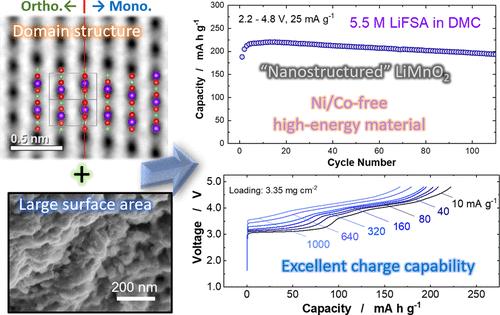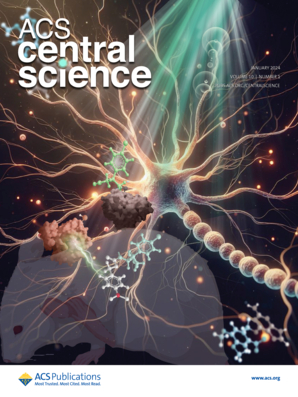A Practical and Sustainable Ni/Co-Free High-Energy Electrode Material: Nanostructured LiMnO2
IF 12.7
1区 化学
Q1 CHEMISTRY, MULTIDISCIPLINARY
引用次数: 0
Abstract
Ni/Co-free high-energy positive electrode materials are of great importance to ensure the sustainability of Li-ion battery production and its supply chain in addition to minimizing environmental impact. Here, nanostructured LiMnO2 with both orthorhombic/monoclinic layered domains is synthesized, and its lithium storage properties and mechanism are examined. High-energy mechanical milling is used to convert the metastable and nanosized LiMnO2 adopting the cation-disordered rocksalt structure to an optimal domain-segregated layered LiMnO2. This positive electrode produces an energy density of 820 W h kg–1, achieved by harnessing a large reversible capacity with relatively small voltage hysteresis on electrochemical cycles. Moreover, voltage decay for cycling, as observed for Li-excess Mn-based electrode materials, is effectively mitigated. Furthermore, by determining the structure–property relationships of different LiMnO2 polymorphs, LiMnO2 with similar domain structure and surface area is successfully synthesized with an alternative and simpler method, without the metastable precursor and high-energy mechanical milling. The cyclability of domain-containing LiMnO2 is also improved with the use of a highly concentrated electrolyte coupled with a lithium phosphate coating due to the suppression of Mn dissolution. These findings maximize the possibility of the development of high-energy, low-cost, and practical rechargeable batteries made from sustainable and abundant Mn sources without Ni/Co.

一种实用且可持续的无镍/无钴(Ni/Co)高能电极材料:纳米结构二氧化锰锂
不含镍/铜的高能正极材料对于确保锂离子电池生产及其供应链的可持续性以及最大限度地减少对环境的影响具有重要意义。本文合成了具有正交/单斜层状结构的纳米二氧化锰锂,并研究了其储锂性能和机理。利用高能机械研磨将采用阳离子无序岩盐结构的析出型纳米二氧化锰锂转化为最佳的层状析域二氧化锰锂。这种正极通过利用电化学循环中相对较小的电压滞后和较大的可逆容量,产生了 820 W h kg-1 的能量密度。此外,在锂锰电极材料中观察到的循环电压衰减现象也得到了有效缓解。此外,通过确定不同锰酸锂多晶体的结构-性能关系,我们采用了另一种更简单的方法,即不使用析出前驱体和高能机械研磨,成功合成了具有相似畴结构和比表面积的锰酸锂。由于锰的溶解受到抑制,在使用高浓度电解质和磷酸锂涂层的情况下,含畴二氧化锰锂的循环性也得到了改善。这些发现为开发高能量、低成本、实用的可充电电池提供了最大的可能性,这些电池是由可持续的丰富锰资源制成的,不含镍/钴。
本文章由计算机程序翻译,如有差异,请以英文原文为准。
求助全文
约1分钟内获得全文
求助全文
来源期刊

ACS Central Science
Chemical Engineering-General Chemical Engineering
CiteScore
25.50
自引率
0.50%
发文量
194
审稿时长
10 weeks
期刊介绍:
ACS Central Science publishes significant primary reports on research in chemistry and allied fields where chemical approaches are pivotal. As the first fully open-access journal by the American Chemical Society, it covers compelling and important contributions to the broad chemistry and scientific community. "Central science," a term popularized nearly 40 years ago, emphasizes chemistry's central role in connecting physical and life sciences, and fundamental sciences with applied disciplines like medicine and engineering. The journal focuses on exceptional quality articles, addressing advances in fundamental chemistry and interdisciplinary research.
文献相关原料
| 公司名称 | 产品信息 | 采购帮参考价格 |
|---|
 求助内容:
求助内容: 应助结果提醒方式:
应助结果提醒方式:


